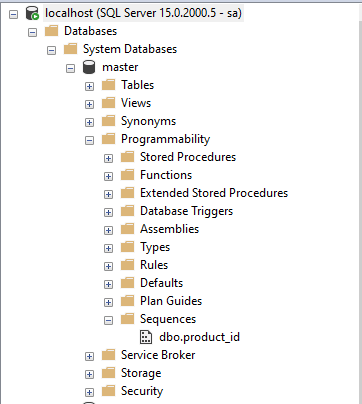Learning Objective
The objective of this tutorial is to teach you how to use the Sequence object in SQL Server to generate a sequence of numeric values in a particular order.
What is a Sequence
A Sequence is a list of number which is in particular order. In Sequence, ordering of the number is important. For example, the (1,2,3,4) is a sequence however the (4,3,2,1) is a entirely difference sequence although all the numbers in both the Sequence are same.
In SQL Server, a sequence is a user-defined object that generates a sequence of numbers in a particular order. A sequence of numeric values can be in ascending or descending order at a defined interval and may cycle if requested.
SQL Server CREATE Sequence syntax
CREATE SEQUENCE allows you to create a new sequence in SQL Server. The syntax for creating a new sequence is shown below:
CREATE SEQUENCE [schema_name.] sequence_name
[ AS integer_type ]
[ START WITH start_value ]
[ INCREMENT BY increment_value ]
[ { MINVALUE [ min_value ] } | { NO MINVALUE } ]
[ { MAXVALUE [ max_value ] } | { NO MAXVALUE } ]
[ CYCLE | { NO CYCLE } ]
[ { CACHE [ cache_size ] } | { NO CACHE } ];
In this syntax,
- schema_name – Name of the schema where the sequence belongs.
- sequence_name – Name of the sequence you wish to keep.
- AS integer_type – You can use any valid inter type for sequence. For example,
TINYINT,SMALLINT,INT,BIGINT,DECIMALorNUMERICwith a scale of 0. Default is BIGINT. - START WITH start_value – Defines the start value of the sequence. The start value must be within the range of
min_valueandmax_value. The default value ofstart_valueismin_valuefor an ascending sequence andmax_valuefor a descending sequence. - INCREMENT BY increment_value – Defines the increment value of the sequence object when you call the
NEXT VALUE FORfunction. In case theincrement_valueis negative then it is a descending sequence otherwise ascending sequence. Remember thatincrement_valuecan’t be 0. - [ { MINVALUE [ min_value ] } | { NO MINVALUE } ] – Defines the lower bound of the sequence objects. In case of
TINYINT, default value is 0 and for all other datatypes it is negative. - [ { MAXVALUE [ max_value ] } | { NO MAXVALUE } ] – Defines the upper bound of the sequence object. Default is maximum range of the data types of the sequence objects.
- [ CYCLE | { NO CYCLE } ] – You can use the
CYCLEclause if you want the value of the sequence to be restart from themin_valuefor the ascending sequence object andmax_valuefor the descending sequence object or throw an exception when the range ofmin_value andmax_valueexceeds. By default, SQL Server usesNO CYCLEfor new sequence objects. - [ { CACHE [ cache_size ] } | { NO CACHE } ] – This is used to define the number of sequence values to cache to improve the performance of the sequence by reducing the numbers of disk I/O. By default, SQL Server uses NO CACHE for a new sequence objects.
SQL Server SEQUENCE Examples
To understand the concept of sequence with more clarity, let’s check some examples of sequence.
1) Creating a simple sequence
You can create a new sequence by using CREATE SEQUENCE statement. In this example, we have created a sequence named product_id with start value 100 and increment value 10 and the data type is integer (INT).
CREATE SEQUENCE product_id AS INT START WITH 100 INCREMENT BY 10;
You can also view the sequence objects in SQL Server Management Studio by expanding Programmability > Sequences as shown below:

The below statement will return the current value of the sequence object.
SELECT NEXT VALUE FOR product_id;
Output
Current_value 100 (1 row affected)
In the above example, NEXT VALUE FOR generates a sequence for the object product_id.
Each time you executes the above statement, the sequence will increment by 10.
SELECT NEXT VALUE FOR product_id;
This time, the above statement will generate the output 110 as below.
Output
Current_value 110 (1 row affected)
2) Using a Sequence in a Single Table
First, create a new schema generalstore as follows.
CREATE SCHEMA generalstore;
Next, create a new table named product in genrealstore schema.
CREATE TABLE generalstore.product ( product_id INT PRIMARY KEY, product_name nvarchar(100) NOT NULL, quantity INT NOT NULL );
Now, create a sequence name product_id_seq as below.
CREATE SEQUENCE product_id_seq AS INT START WITH 100 INCREMENT BY 1;
After that, insert three rows into the generalstore.product table. We will use product_id_seq for inserting new product if into the table.
INSERT INTO generalstore.product (product_id, product_name, quantity) VALUES (NEXT VALUE FOR product_id_seq,'Milk',20); INSERT INTO generalstore.product (product_id, product_name, quantity) VALUES (NEXT VALUE FOR product_id_seq,'Bread',25); INSERT INTO generalstore.product (product_id, product_name, quantity) VALUES (NEXT VALUE FOR product_id_seq,'Eggs',160);
Finally, you can check the content of the product table using select query.
select * from generalstore.product;

You can notice that the product_id column has been inserted using the product_id_seq sequence. Here first value is 100 and incremented by 1 for each new row.